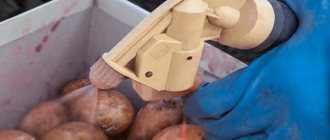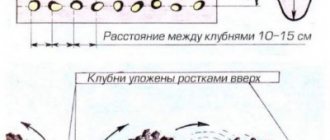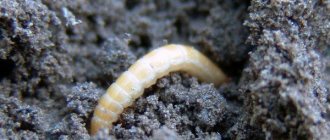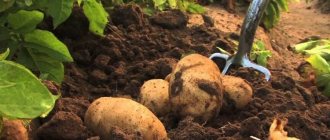Perennial dahlias are gardeners' favorites. They will decorate and cover any, even the most unassuming area. And due to the lush foliage and large flowers, they will create a bright floral accent in any corner of the garden. Breeders have created 15,000 varieties of dahlias, which are tuberous perennials. Every spring we take tubers out of the basements and carry out the procedure of division and germination, otherwise the plants will be huge and spreading. And if we dream of getting a few more specimens, then we cannot do without knowledge on the reproduction of Astrov representatives.
We dig up planting material before severe frosts
Before dividing the dahlia, it must be dug up. This must be done before frost begins. If severe frosts suddenly begin and the dahlias are not dug up in a timely manner, the fleshy stem will die, and when it gets warmer, it will rot. This process can then affect the tubers. Therefore, it is necessary to dig up the flower before severe frosts occur so that the plant does not die.
Low-growing dahlias, when compared with other flowers, for example, gladioli, are less picky about weather conditions.
This means that digging up tubers can be carried out in rainy weather. Important! In order for the tubers to last until the warm season, and there is nothing left to separate, it is necessary that they ripen. To do this, two to three weeks before digging up the plant, you do not need to water it.
Separation dates for garden dahlias
It is necessary to divide dahlias, rejuvenating them and leaving root tubers of the optimal size, while they are out of the soil - before or after storage. The choice between autumn and spring division should be made depending on convenience, habits or capabilities, weather conditions in the fall during digging, and even the conditions in which the rhizomes are stored.
Each of the two separation options has its own advantages and disadvantages:
Autumn division of dahlias
It is considered the simplest and most productive way. In the fall, when the rhizomes are dug up, they still have to be cleaned, treated with fungicides, inspected, and damaged parts removed. Therefore, the cuttings that are already clean and ready to go into storage can only be divided so that in the spring you can immediately begin preparing for planting.
The main advantages of this method are the lower risk of infection by viruses and diseases, and the simplicity of the process itself. But the risks are also great:
- smaller divisions tolerate wintering outside the soil less well;
- higher risk of drying out or disease.
Spring division of dahlias
It is carried out before the awakening of rhizomes, before the start of the gardening season. Overwintered dahlias are re-inspected and discarded. In the spring, you can assess their real condition; by the end of March (and with proper storage, this is when the dormant period ends) the buds stand out well, they are easy to detect and evaluate.
The percentage of loss of planting material is less, and the size and quality of the cuttings is easier to determine. Large dahlias are stored better, so many people prefer dividing them before preparing for planting rather than after digging them up. True, the difficulty of separation, the hardness and flaccidity of the peel, and the greater risk that infection will spread to a large nest are not always offset by the advantages.
Whatever separation option is chosen, it should be remembered that careful work and thorough inspections, lack of haste are the key to success in both cases.
Autumn division of dahlia rhizomes. © uneruta
How to divide dahlias
Perennial varieties can be propagated using the following options: dividing the tuber or cuttings. Although it is possible to combine two methods at once, thanks to which one strong and healthy flower will turn into three or more dahlias.
How many divisions will come out will depend on the number of buds. They can be seen at the top of the tuber and are usually found around the stem of the flower. It is quite difficult to examine such buds when they are in a state of formation.
In this situation, you can resort to the following methods:
- Divide dahlias not in the fall, but in the spring. At this time, the process of bud germination will begin, so they will be easier to notice.
- A couple of days before digging up the plant, trim its stem. This measure also promotes bud germination.
Cuttings, in fact, have no other function than propagation of dahlias. This method is also very effective - from one rhizome you can get as many cuttings as there are buds on it.
Rules for planting in the ground
There are no uniform dates for planting dahlias in the ground - they depend on the weather. The main condition is well-warmed soil, constant positive daytime temperatures, and the absence of frosts that are destructive for tender sprouts.
How to plant:
- dig holes with a depth of 20 to 30 cm, the distance between them is at least 0.5 m;
- pour humus (1/3-1/4 bucket), ash (1 cup), superphosphate (2 tbsp) into each, mix;
- pour in 5-6 liters of water, wait until completely absorbed;
- place a division at the bottom with the sprouts facing up, cover it - the sprout remains at soil level or slightly protrudes above the surface.
If there is no natural organic matter, then humus will be replaced by nitrophoska, urea, ash - potassium sulfate, potassium nitrate. Dilute according to fertilizer instructions.
How to properly divide dahlia tubers
Tubers are divided in spring or autumn. But, nevertheless, the latter option is preferable, since in this case it will be easier for the roots to endure storage; processing and dividing the tuber is easier, since it is not yet as rough as in the spring, its peel is thin. In addition, gardeners usually have more time in the fall than in the spring. Therefore, they can carefully examine the tubers, process and disinfect the cut areas.
Before cutting dahlias or separating tubers, the rhizomes are dug up and processed.
Important! The first cold weather can harm the leaves of the plant, however, they do not pose a danger to the tubers.
Conventional standard for dahlia divisions
A “planting unit” or standard dahlia division is one tuber with 1-3 strong, high-quality buds and well-developed, high-quality roots. Sometimes it is one “root”, and sometimes it is several, if the bud is one and only common.
In order for dahlias to develop normally, the inflorescences not to become smaller, the plant not to become depleted and to ripen normally, it is worth leaving two, or at least three, stems on each bush. It is recommended to remove excess shoots in the early stages of development, but it is better if the maximum number of shoots is limited even before germination or planting by controlling the number of buds.
It is possible to deviate from this standard or norm. In each specific case, the method of division, the lines along which to cut the rhizomes and how many buds and tubers should be left must be determined individually. It is always better to start with a thorough examination and identification of those buds that are on each rhizome. If it’s difficult to navigate, you can mark the lines and buds with a marker.
Tuber preparation
Dahlias should be dug up during the period when severe frosts begin. In most regions of Russia, this period falls in mid-October. By this time, the plant will wither or freeze, and the inflorescences will fade. To prevent the flower from rotting, becoming infected with a fungus, and to better withstand storage during the cold season, the plant is stopped watering a couple of weeks before the tubers are dug up.
In order not to injure the tubers when digging, you need to step back from it by about 30 centimeters along the entire diameter and carefully dig in. Thanks to this, you can trim very long roots without damaging the root system.
After this, the tubers must be carefully turned with their roots up and left to dry for several hours. If there is high humidity outside, the tubers should be brought into a room where it is warm and dry.
Attention! If it rains when digging up the plant, the dahlia should be covered with waterproof material, this will help avoid rotting of the roots.
Tools
Before dividing dahlias in the fall, let’s arm ourselves with these tools and other necessary things:
- We will need a sharp pruning shears.
- It needs an equally sharp knife to pair it with. Of course, it is better to use a garden one. In the absence of one, a kitchen knife will cope with the task.
- Potassium permanganate - for disinfecting tubers.
- A container in which disinfection will take place and clean, cool water.
- Also prepare identification tags with the names of the varieties.
- Take out regular plastic bags.
Tuber division
For the division procedure, it is advisable to select strong and intensely flowering bushes. The tubers are divided as follows:
- Before digging up the bush, the stems are cut off, leaving parts of about 30 centimeters. The stems are not left long because they can break and injure the root. When the bush is dug up, part of the soil is carefully removed from the tuber, then it is washed with water. When washing, small unformed nodules are cut off, as well as tubers that are bent and intertwined. They preserve the main tubers that extend from the root and have growth buds. They are the ones who will separate.
- Long tubers are reduced to 15 centimeters. If the plant consists of several trunks, the tuber is divided into several bushes depending on how many there are. The division is carried out carefully, the rhizome is loosened. It may be necessary to cut the mother tuber.
- The roots are washed again, the stems are shortened to two centimeters.
- You can leave the tubers on the veranda for two or three days, but if there are frosts at night, you need to put them in a dry and warm place.
How to properly divide dahlia root
When the bushes are dug up and washed, they need to rest for two to three days. Then you can separate them or remove them for the winter and divide them in the spring.
Autumn division
To divide the rhizome you will need sharp scissors or a knife. The procedure is carried out as follows:
1. The rest of the stem is divided in half using a sharp knife so that the buds remain on both sides. This must be done carefully so as not to break the stem from the rhizome. If this does happen, it’s okay.
2. The rhizome is stretched so that it breaks in two. After this, the resulting pieces are inspected. If there are more than two buds on them, this stage can be gone through again, dividing the rhizome into two parts and stretching the tubers. Thanks to this procedure, several parts are obtained from one large root, capable of becoming full-fledged bushes in the future.
You may be interested in: When to dig up dahlias in the fall: types of flowers When to dig up dahlias in the fall and how to store until planting in the spring? The most favorable days according to the lunar sowing calendar for germinating annual dahlias
3. The ideal planting material is a whole tuber or a part of it with a bud. If the tuber has two buds, you can divide it in two using a sharp knife.
Spring division
When dividing in spring, the tubers are removed from storage a few days before the planting season begins and the buds are examined. Separation can be carried out if the kidneys are awakened. It happens that they are impossible to see because they have dried out during the cold season. In such a situation, you need to sprinkle water on them and leave them to germinate. When this happens, carry out the division procedure using the method described above.
Basic methods of reproduction
By propagating dahlias, you can get not only young plants, but also experiment, creating new specimens that will differ in size and color shades. There are 5 known ways to divide flower crops:
- tubers;
- using vaccination;
- seed method;
- cuttings;
- reproduction by “sports”.
Each method has a right to exist, but not all of them are simple and easy to implement. In addition, the varietal qualities of the original specimens are not always preserved, but if you want to experiment, then there are more than enough opportunities.
Seed propagation
Flower growers know how to propagate dahlias to obtain new, interesting forms.
Growing from seeds provides this opportunity. To do this, faded inflorescences are cut off in the autumn. They are hung to ripen in a dry room. Ripe seeds are selected from the inflorescences, dried again and placed in paper bags until spring. In March you can sow seedlings.
Advice! If frosts come too early, the inflorescence can be cut off and placed in water until it blooms. Then use the technique described above.
Division of "sports"
Dividing dahlias into “sports” is a relatively new and unusual technique. “Sports” refer to genetic mutations when a branch with a flower of a different shade appears on the plant. To obtain a new variety, it is carefully cut and divided using the cutting method, leaving it for adaptation and rooting until the next season, and after spring planting, the growth of the new specimen is observed.
Use of grafting
Not everyone knows how to propagate dahlias by grafting, since this is a troublesome process that requires a lot of effort and time. But this method allows for earlier flowering and the tubers grow to normal size by autumn. Usually, when dividing, there are always tubers left that are used for grafting.
The tuber is washed, dried and a deep hole is made in it. The cutting is sharpened, its lower part, taken from an exotic (bright, unusual) specimen, and inserted into a tuber with a pre-prepared notch, wrapped and planted for subsequent growth.
But basically, dividing dahlias in the spring is carried out using the two most popular methods - dividing tubers and cuttings. These are the most convenient and uncomplicated methods of reproduction, but some tricks exist here too.
Methods for stimulating early flowering and plant formation are shown in the video:
Propagation of dahlias by cuttings
Propagation can be done by cuttings. Such shoots are obtained at the stage of tuber germination. Cuttings should be carried out in the spring. With the onset of warmth, the buds on the tubers awaken and sprout.
Tubers are removed from their storage places, inspected, withered and bad specimens are thrown away, and good ones begin to germinate.
To grow a cutting, you should purchase a special device or plant it in a coconut substrate. The container is filled to the middle with the mixture. The tuber is also not placed completely in the substrate - the top, where the buds are located, should remain above the surface.
After a couple of weeks, the flower stem will begin to grow. Once its height exceeds 10 cm, carefully cut it between the kidneys using a well-sharpened knife or scissors.
In order for the cutting to take root, it must be placed in a glass with a small amount of water. After some time, the first roots form. Another option is to immediately plant in a substrate of coconut fibers, sand and peat.
Cuttings of dahlias: the whole process step by step
After about 2-3 weeks, when the shoots reach a length of 8-10 cm (2-3 internodes), start cuttings.
Dahlia cuttings can be prepared in two ways - cut with a sharp knife or broken off with a heel - a piece of root tuber. The latter take root much better. First of all, you should pay attention to strong, plump shoots; they take root better and develop faster in the future. Using a sharp knife, carefully separate the shoot from the root tuber, grabbing a small piece of the rhizome - the heel.
Make the cut under the leaf node, with a distance of 3–5 mm from the leaf petioles, then the formation of roots will begin faster. If the shoots are located close to each other on the root tuber, you can cut off a group at once, and then calmly divide them on the table, one cutting at a time.
If there is a lack of dahlia planting material, weaker shoots can also be taken from cuttings. The main thing is to grab at least a small, literally a few millimeters thick, piece of rhizome.
When preparing cuttings, do not get carried away, because we will also use the root tuber to produce flowers. Therefore, try to take the shoots away from the root collar.
Remove the lower leaves, leaving only the petioles. Powder the base of the cuttings with a root formation stimulator (Kornevin) and place them to a depth of no more than 1.5–2 cm in a cutting box filled with spilled substrate. This can be a mixture of neutral peat and sand in a 2:1 ratio (or perlite) or even pure perlite.
Gently, using your fingers, compact the soil around the base of the cuttings for better contact with the ground. If there are a lot of dahlia cuttings, they can be planted in a common container. The main thing is to try to plant them at an angle (about 45 degrees), with such density that the leaves do not touch each other. Cover the cuttings with a plastic bag or a transparent lid, water as the top layer of soil dries, ventilate periodically, shaking off condensation from the shelter. The optimal temperature for rooting dahlia cuttings is +20…+25 °C.
From the buds located in the axils of the leaves remaining on the mother plant, new shoots will grow, which after 2–2.5 weeks can also be used for cuttings. In principle, cuttings can be continued until April, cutting cuttings both from growing shoots on the root tuber and from the rooted cutting itself. However, the root tuber from which the cuttings are obtained must still grow shoots for flowering in the current season, so you should not get carried away. Place the pots with queen cells in a cool (+14...+16 °C) and bright room before planting them in the garden. If necessary, growing shoots can be tied to a support.
Propagation of dahlias by tubers
Dahlias can also reproduce by tubers. Unlike cuttings, dividing by tubers is preferable to be done in the fall. The rhizomes are prepared, washed, dried, examined, and the buds are counted. It is more convenient to first divide a large root in two so that the same number of buds remains on both parts.
You only need to cut the tuber with a sterile, well-sharpened knife. To disinfect, you can use alcohol or ignite the knife over a fire.
First, an incision is made on the top of the tuber, where the stem is located. Then you need to take two edges and carefully stretch them to the sides, thereby breaking the rhizome into two parts.
To soak the cuttings, you can use a saturated manganese solution. Then they are laid out on newspaper to air and dry.
Germinated cuttings and tubers can be planted into the soil when the risk of severe frosts has disappeared.
Usually this is done no earlier than May.
Cuttings of dahlias in autumn
To propagate dahlias by cuttings, the tubers can be prepared in the fall. After treatment of soil residues, the following measures are carried out:
- Root tubers for further cuttings are carefully examined. Damaged ones are rejected. The damaged areas are cut off from the remaining ones.
- Remove all root threads so that there are only tubers.
- Trim the bottom by about 0.5 cm.
- The stem is shortened to 2 cm and divided with a knife into two equal parts along with the root, so that each fragment has the same number of vegetative buds.
- The last stage is to remove the remaining stem completely.
In order for the sections to dry and a film to form on them, the prepared material is left for 2–3 days in a room with good air circulation. Then put into a storage container. They check it several times before spring. If dark spots appear, they are removed. A root prepared in the fall produces a stronger plant.
There is another method of cutting dahlias, suitable even for lazy people, when there is no time or desire to obtain seedlings for propagation from the root:
- In the fall, before frost, material is harvested from the lower part of the stems so that there are approximately 3 nodes on them.
- A nutrient substrate is poured into the container and the cuttings are deepened with the lower part by 3–5 cm.
- Before rooting, the container is left in the room. When the seedlings take root, they are taken out to a cool room with good lighting.
There they will remain until they are transferred to the flowerbed. This cutting method is rarely used. The material is complete, but its survival rate is low, so cuttings must be prepared in large quantities.
Rules for storing dahlia tubers
If the tubers are stored incorrectly, the dahlia may rot or dry out. This happens due to temperature changes or high or low humidity. To store dahlias, you should choose places where the temperature and humidity values are stable. It is preferable to use cellars and basements for this.
There are several options for storing dahlia tubers:
- In sand or sawdust. With this method, the roots are preserved until the next season, however, it is necessary to strictly control the level of moisture in the substrate. If the climate is dry, it must be additionally moistened, otherwise the tubers will dry out.
- In vermiculite. The substance retains water well, but when the temperature rises, tubers begin to sprout.
- In clay. You can preserve dahlia tubers using clay. It needs to be diluted with water to a creamy consistency and the tubers should be immersed in it. In the spring you will need to hit the crust that has formed, the clay will crumble and the buds will sprout.
- In paraffin. Especially valuable specimens that can germinate in the middle of winter are usually stored in this substance. To do this, paraffin is heated to 70°C and the tubers are immersed in it one by one. After the crust has hardened on them, the dahlias are placed in boxes or crates for storage.
If you follow all the rules, you don’t have to return to the issue of purchasing new tubers. Dividing and propagating dahlias is a fairly simple task that even an inexperienced gardener can handle.
Site selection and preparation
Heat-loving dahlias are easily damaged even by minor frosts, so lowlands with stagnant moisture and poor air circulation are not suitable for them. They grow best on flat or elevated areas where there are no through winds - the fragile stems break in strong winds.
It is not recommended to plant them next to buildings, fences, or close to tall trees, since lack of light (less than 6 hours a day) causes the flowers to become smaller and the color richness is lost. In areas where the groundwater level is less than 1 m, moisture stagnation is observed, the tubers begin to hurt, the supply of nutrients is disrupted, and the bush dies. In this case, if there is no choice, high embankment ridges are built.
The place for the ridges, flower beds are prepared in the fall - they dig them up (depth 30-35 cm), add rotted manure (10-15 kg/1 m²), potassium sulfate and superphosphate (1 tbsp./1 m²). In May, when there are 2-3 weeks left before planting, they dig again, but to a depth of 20-25 cm, adding wood ash (2-3 tbsp), Agricola and urea (1 tbsp each) per square area. .
Ways to improve the structure and composition of the soil:
- if the soil is heavy and dense, then coarse sand is added when digging - it will make the soil more loose and breathable;
- sandy ones are “weighted” with peat, vermiculite, clay - they retain moisture well;
- for alkaline ones add a little peat, for acidic ones (pH 4-5) - slaked lime powder (0.3-1 kg/1 m²) or chalk, dolomite flour.
Since lime slows down the growth of beneficial bacteria necessary for the decomposition of organic matter, lime and organic matter cannot be added together. Organic matter is added in the fall, and lime in the spring. Nitrogen and potassium fertilizers are quickly washed out of the soil, so they are added when digging and into the planting hole.
Germination and division of dahlias in the spring, when to take out the tubers after winter
When to take out dahlias for germination, how to prepare them for planting in the spring and divide them correctly - you need to know all this so that the result is gorgeous flowers from ordinary-looking tubers. You can study this information in our article, where we tried to describe in detail all the nuances of preparing dahlia tubers for spring planting.
When to get dahlias in spring
In Siberia, the Urals, the Moscow region, and the south of the country, dahlia tubers are obtained at different times. This is explained by the fact that these flowers should be planted in heated soil, and taken out of the basement, refrigerator or other storage three to four weeks before planting.
The soil temperature suitable for planting tubers at a depth of 10 cm is +10..+12 degrees. In this case, the air temperature during the day should be kept at around + 10, and at night – at +5 degrees. If you plant already sprouted dahlias and there is frost, the tender shoots will freeze.
Of course, everything depends on the vagaries of the weather, but you can determine the approximate timing of when to pull out the tubers for germination:
- In the Moscow region and other regions of Central Russia - in mid or late April.
- In Siberia, in the Urals - in early May.
- In the south of the country (in Krasnodar, Kuban), dahlias are obtained in the third decade of March or early April, since in mid-spring the soil in areas in the southern regions has already warmed up to the desired temperature.











